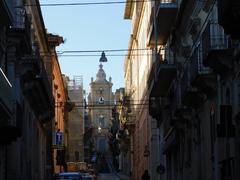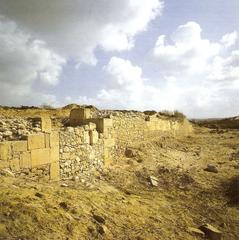
Lago di Santa Rosalia Visiting Hours, Tickets, and Travel Guide – Ragusa, Italy
Date: 04/07/2025
Introduction: History and Significance
Lago di Santa Rosalia, set amidst the picturesque Hyblaean Mountains in southeastern Sicily, is an artificial reservoir near Ragusa that harmoniously merges cultural heritage with ecological value. Created in the late 20th century by damming the Irminio River, the lake was designed to alleviate chronic water shortages and support agriculture. Over time, it has developed into a haven for biodiversity and a sought-after destination for outdoor recreation. Its dedication to Santa Rosalia, the patron saint of Palermo, underscores the site’s deep-rooted cultural resonance and the enduring relationship between Sicilian communities and their environment (Discover Lago di Santa Rosalia: History, Environmental Impact & Visitor Guide, Lago di Santa Rosalia: Environmental and Cultural Treasure in Ragusa, Sicily).
Lago di Santa Rosalia now serves as both an ecological hotspot and a venue for hiking, fishing, birdwatching, and nature photography. Its proximity to UNESCO-listed Baroque towns like Ragusa Ibla and Modica further enhances its appeal, offering visitors a unique blend of natural and cultural experiences (Go Ask a Local, Stories by Soumya).
Table of Contents
- Introduction: History and Significance
- Historical Background
- Environmental Impact
- Visitor Information
- Frequently Asked Questions (FAQ)
- Conclusion
- References
Historical Background
Origins and Construction
Lago di Santa Rosalia was constructed between the 1970s and 1983 as a response to Ragusa’s pressing water needs. By damming the Irminio River, a significant watercourse in the Hyblaean Mountains, the region established a reservoir that today holds up to 25 million cubic meters of water. The creation of the lake transformed local agriculture, enabling the irrigation of olives, grapes, and vegetables and stabilizing water supply for the surrounding communities (Guidasicilia).
Socio-Economic Role
Before the lake’s creation, frequent droughts limited agricultural productivity. Now, Lago di Santa Rosalia not only supports farming but also nurtures rural tourism. Its scenic trails, fishing spots, and tranquil landscapes attract locals and travelers, diversifying the local economy and enriching the cultural tapestry of the Ragusa area (Balarm).
Environmental Impact
Ecosystem & Biodiversity
The reservoir’s creation led to the submergence of parts of the Irminio valley, converting terrestrial habitats into aquatic and wetland environments. Today, Lago di Santa Rosalia hosts diverse Mediterranean flora—willows, conifers, lentisk, reeds—and is a haven for migratory and resident birds, rare reptiles such as the Sicilian pond turtle, and a variety of fish (carp, perch, trout). The surrounding forests and slopes shelter mammals like wild rabbits and foxes, as well as a range of insects and endemic beetles (Constructive Voices).
Conservation & Climate Challenges
While the lake regulates regional water flow and aids in drought resilience, it faces challenges including agricultural runoff, habitat fragmentation, invasive species (notably the zebra mussel, Dreissena polymorpha), and the impacts of climate change—such as erratic rainfall and reduced water levels (Biodiversity Journal, Ragusa H24). Ongoing conservation measures involve wetland protection, reforestation, buffer zones, and community education initiatives.
Responsible Tourism
Tourism brings economic and educational benefits but can also lead to habitat disturbance and litter. Authorities have established designated picnic areas, waste collection points, and informative signage to promote responsible behavior. Adhering to “leave no trace” principles and respecting local wildlife are essential for preserving the lake’s integrity (Visit Italy).
Visitor Information
Visiting Hours and Access
Lago di Santa Rosalia is open to the public year-round, with no formal entrance gates or set hours. Daytime visits—from dawn to dusk—are recommended for safety and enjoyment. The site is best reached by car (approximately 15–20 minutes from Ragusa city center via SP25 or SP10/SP60), with informal parking available near main access points.
Tickets and Tours
There is no general entrance fee. Guided nature walks, birdwatching tours, or fishing activities may require advance booking or permits. Fishing permits are available from local vendors or regional associations and are mandatory for anglers.
Activities and Facilities
- Hiking & Walking: Several marked trails encircle the lake, suitable for all fitness levels. Routes like the Diga di Santa Rosalia Loop (11.5 km) and shorter circuits from Giarratana offer panoramic views (Komoot).
- Cycling: The gently rolling terrain is ideal for road or mountain biking. Bike rentals are available in Ragusa.
- Birdwatching: The reed beds and shoreline attract coots, herons, ducks, and raptors—binoculars are highly recommended.
- Fishing: Popular for carp, perch, and catfish. Permits are required.
- Picnicking: Shaded areas are available, but bring your own food and supplies—there are no commercial facilities or restrooms on-site.
- Boating: Non-motorized craft like kayaks and canoes are permitted; swimming is discouraged due to safety and water quality concerns.
Directions and Accessibility
Public transportation is limited; car travel is preferable. The natural terrain is mostly unpaved and may be challenging for visitors with limited mobility. Some trails are accessible, but wheelchair access is minimal.
Nearby Attractions
Combine your visit with nearby heritage sites:
- Ragusa Ibla: Baroque historic center and UNESCO World Heritage site (Stories by Soumya)
- Modica and Scicli: Renowned for Baroque architecture and chocolate (Go Ask a Local)
- Marina di Ragusa: Coastal destination perfect for extending your trip (Lotus Eaters Travel)
- Donnafugata Castle: Historical site south of Ragusa
Frequently Asked Questions (FAQ)
Q: Are there entrance fees or tickets?
A: No, access is free. Fishing or special tours require permits.
Q: What are the best months to visit?
A: Spring (April–June) and autumn (September–October) for mild weather and bird migration.
Q: Can I fish at the lake?
A: Yes, with a valid permit.
Q: Is Lago di Santa Rosalia suitable for families?
A: Yes, but supervise children near the water and bring supplies.
Q: Are there facilities or restrooms on-site?
A: No; nearest services are in Ragusa or Giarratana.
Q: Is the site accessible for visitors with disabilities?
A: Accessibility is limited due to natural terrain.
Q: Are pets allowed?
A: Yes, but must be controlled to protect wildlife.
Conclusion
Lago di Santa Rosalia is a testament to the synergy of human ingenuity and natural preservation. Visitors can immerse themselves in tranquil Mediterranean landscapes, enjoy a range of outdoor activities, and discover the area’s cultural richness. Responsible tourism—respecting regulations and minimizing environmental impact—is essential to safeguarding this unique ecosystem. Plan your visit, explore the wonders of Ragusa, and contribute to the ongoing story of Lago di Santa Rosalia.
For guided tours, real-time updates, and further tips, download the Audiala app and follow us on social media.
References
- Discover Lago di Santa Rosalia: History, Environmental Impact & Visitor Guide (https://sicilyenvironment.org/)
- Lago di Santa Rosalia: Environmental and Cultural Treasure in Ragusa, Sicily (https://www.balarm.it/news/porta-il-nome-della-santuzza-ed-e-un-incanto-il-lago-e-la-diga-tra-i-boschi-iblei-130625)
- Lago di Santa Rosalia Visiting Hours, Tickets, and Outdoor Activities in Ragusa (https://goaskalocal.com/blog/travel-guide-to-ragusa-sicily/)
- Lago di Santa Rosalia Visiting Hours, Tickets, and Travel Guide to Ragusa’s Natural Gem (https://www.comune.ragusa.it/it/vivere/diga-santa-rosalia)
- Guidasicilia: Lago Santa Rosalia e Foce del Fiume Irminio (https://www.guidasicilia.it/itinerario/lago-santa-rosalia-e-foce-del-fiume-irminio/1001498)
- Constructive Voices: Italy Biodiversity (https://constructive-voices.com/italy-biodiversity/)
- Stories by Soumya: Things to Do in Ragusa Sicily (https://www.storiesbysoumya.com/things-to-do-ragusa-sicily/)


